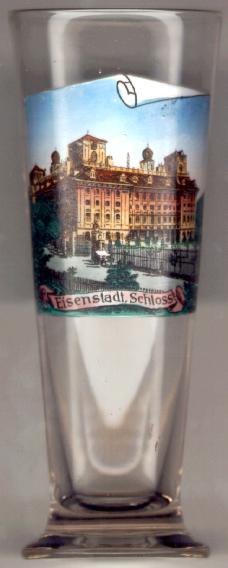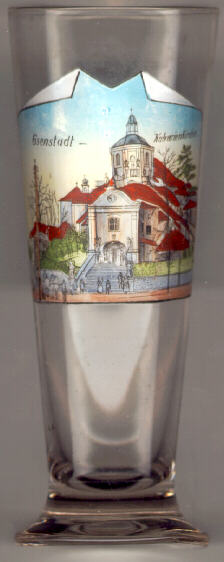

|
| ÖSTERREICH | AUSTRIA |
| Bundesland: Burgenland | |
| Stadt: Eisenstadt |
Eisenstadt was first mentioned in a chronicle of 1118. The earliest document
referring to Eisenstadt dates from 1264. In 1373 the village received the status of a town.
Between 1445 and 1648 Eisenstadt was in possession of the Habsburgs. Thereafter,
it enjoyed the status of a Royal Hungarian free city. It was one of the residences
of the Esterházy dynasty. After World War II and the
Treaties of Paris (Saint-Germain 1919 and Trianon 1920) a referendum was held in 1921 in the German-speaking parts
of western Hungary. In this referendum Eisenstadt and other parts of the country
voted for joining Austria and became Austria's 9th federal state, Burgenland.
The name of the province is derived from the German names for the Hungarian
counties Sopron (Ödenburg), Moson (Wieselburg)
and Vas (Eisenburg, county seat Szombathely / Steinamanger).
Eisenstadt became the capital of Burgenland in 1925. Since 1960, Eisenstadt
is also the seat of a bishop.

The town centre is marked by
 Schloss Esterházy [left],
the splendid
Baroque residence palace built by Carlo Martino Carlone for Count (1687 Prince) Paul I Esterházy de Galántha
(1635–1713) between 1663 and 1672 transforming the medieval castle. Prince
Paul II Anton (1711–1762), Prince Nikolaus I Joseph (1714–1790)
and Prince Nikolaus II (1765–1833)
were the patrons of the composer Joseph Haydn (1732–1809), who worked here
from 1761 for
30 years as court conductor. The precious festival hall, today called Haydn-Saal,
was the room where Haydn conducted uncounted performances which were also
visited by such famous guests as Ludwig van Beethoven, Franz Liszt, but also by
Lady Hamilton or Admiral Nelson. Successor of Haydn as court conductor was
Johann Nepomuk Hummel between 1804 and 1811.
Schloss Esterházy [left],
the splendid
Baroque residence palace built by Carlo Martino Carlone for Count (1687 Prince) Paul I Esterházy de Galántha
(1635–1713) between 1663 and 1672 transforming the medieval castle. Prince
Paul II Anton (1711–1762), Prince Nikolaus I Joseph (1714–1790)
and Prince Nikolaus II (1765–1833)
were the patrons of the composer Joseph Haydn (1732–1809), who worked here
from 1761 for
30 years as court conductor. The precious festival hall, today called Haydn-Saal,
was the room where Haydn conducted uncounted performances which were also
visited by such famous guests as Ludwig van Beethoven, Franz Liszt, but also by
Lady Hamilton or Admiral Nelson. Successor of Haydn as court conductor was
Johann Nepomuk Hummel between 1804 and 1811.

The  Bergkirche Mariä Himmelfahrt
(Ascension of Our Lady) [right] was built between 1715 and 1772.
The artificial hill on which the church is situated had been constructed in 1701
as a Calvary (Kalvarienberg) after the model of Maria-Lanzendorf
but on a much larger scale. The path, which partly runs underground,
originally contained 33 stations; 24 of these can still be seen today.
The stone statue of the Virgin Mary in the Lady Chapel was sculptured in 1690 after
the model of the one in Einsiedeln in
Switzerland and was brought to Eisenstadt in 1711. Pilgrimages to this site were
particularly popular during the 18th century.
In 1932, the 200th anniversary of Joseph Haydn's birth, the chapel beneath the north
tower of the church was dedicated as mausoleum for Haydn.
Already in 1820 the remains of Haydn had been transferred from Vienna
to Eisenstadt. On that occasion it was discovered that the skull was missing.
In 1895 the skull came into possession of the Gesellschaft der Musikfreunde
(Society of Music Lovers) which exhibited it in their museum in Vienna
until 1954. Only then, the skull was brought to Eisenstadt to be buried in
the mausoleum.
Bergkirche Mariä Himmelfahrt
(Ascension of Our Lady) [right] was built between 1715 and 1772.
The artificial hill on which the church is situated had been constructed in 1701
as a Calvary (Kalvarienberg) after the model of Maria-Lanzendorf
but on a much larger scale. The path, which partly runs underground,
originally contained 33 stations; 24 of these can still be seen today.
The stone statue of the Virgin Mary in the Lady Chapel was sculptured in 1690 after
the model of the one in Einsiedeln in
Switzerland and was brought to Eisenstadt in 1711. Pilgrimages to this site were
particularly popular during the 18th century.
In 1932, the 200th anniversary of Joseph Haydn's birth, the chapel beneath the north
tower of the church was dedicated as mausoleum for Haydn.
Already in 1820 the remains of Haydn had been transferred from Vienna
to Eisenstadt. On that occasion it was discovered that the skull was missing.
In 1895 the skull came into possession of the Gesellschaft der Musikfreunde
(Society of Music Lovers) which exhibited it in their museum in Vienna
until 1954. Only then, the skull was brought to Eisenstadt to be buried in
the mausoleum.
![[scale]](lineal.jpg)